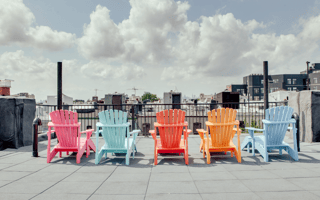
Imagine waking up in a modern, fully-furnished bedroom. Your outfit for the day is crisp and clean because you have a free laundry room in your apartment. After getting dressed, you step into the kitchen, which has just been scrubbed as part of your weekly cleaning service. Your friendly neighbor is already at the table, having made coffee to share. You chat and make plans to watch a movie together in the lounge after work. Finally, you step outside and breathe in the fact that you’re paying less rent than anyone else on your block.
This is the domestic utopia many co-living spaces aim to create. Co-living spaces build on the boarding house tradition of early modern cities, giving residents a private bedroom of their own, with access to common kitchens, bathrooms and living spaces. It’s a lifestyle that comes naturally to some, but is the stuff of nightmares for others.
In order to understand what co-living is really like, Built In NYC spoke to Common. Founded in 2015, the startup has launched numerous beautifully-designed residences in Brooklyn, San Francisco, Chicago and Washington, D.C. According to a Common spokesperson, homes host between nine and 131 individuals.

When it comes to scouting sites for new Common locations, a spokesperson told Built In NYC: “Common looks for neighborhoods that members want to live in: those that have fun things to do, are near mass transit, and have engaged communities already built into the neighborhood.”
A residence on Cornelia Street in New York’s trendy Ridgewood neighborhood costs residents roughly $1,500 a month for a typical twelve-month lease. The space is bright, airy and equipped with ultra-modern appliances and furnishings you’re unlikely to find outside of million-dollar high-rises. Common breaks down the pricing of its units compared to those found on Craigslist, as well as median prices for a studio unit in the area. In total, residents save nearly $400 a month in comparison.
Common believes that demand for alternative housing models in major cities will continue to grow, not only from young renters, but from other populations as well."
Financial savings are only a fraction of what Common aims to offer its residents. The space also places a strong emphasis on community, both in welcoming new residents, as well as day-to-day living. Common spaces are overseen by a home manager, who greets newbies at the front door before helping them settle in. Each resident has the option of connecting to local and national Slack channels for maximum coordination. The sense of community is even built into the living spaces themselves, with ample lounge areas and outdoor spaces that are primed for your next barbecue or book club meeting.

It’s no secret that living space in New York City comes at a premium. Studies indicate that 40 percent of all adults live with roommates, and that number can only be expected to increase as the cost per square-foot of space continues its upward trend. Co-living spaces like Common provide a unique alternative to settling for a smaller or poorly maintained apartment.
What remains to be seen is whether spaces like Common will continue to grow and thrive, or if New Yorkers will develop their own way of getting by in the big city. However, investors who have granted Common with more than $63 million in capital certainly don’t seem to think the co-living concept is going anywhere anytime soon.
“Common believes that demand for alternative housing models in major cities will continue to grow, not only from young renters, but from other populations as well,” said the company spokesperson. “Co-living communities for families and retirees are something Common expects to see in the future.”




